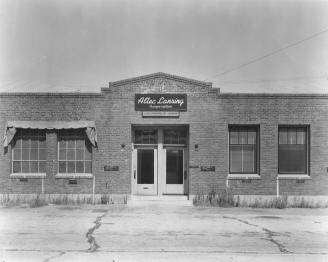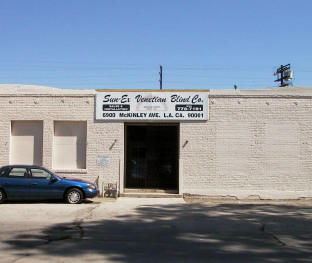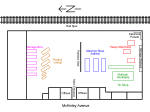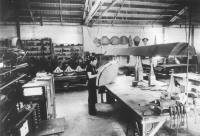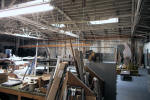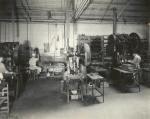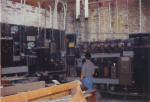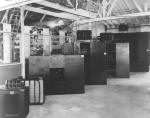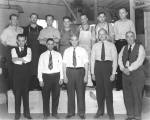|
|
|||||||||||||

|
|
||||||||||||
6900 mckinley
|
|||||||||||||
|
|
|||||||||||||
|
|
The 6900 McKinley Avenue address would be home to LMCo during it's rise to prominence in the loudspeaker industry as well as becoming the loudspeaker manufacturing facility for Altec Lansing until 1951. The Lansing family retained ownership of the property until approximately 1970. At that time, it was sold to it's current owners, the Sun-Ex Venetian Blind Company. In September 2000, the current owners granted permission for Steve Schell and myself to tour and photograph this facility. What follows is a comparison of this facility under Altec/LMCo ownership to today. The basis of this comparison is a series of photos of the McKinley facility from JBL Professional's archive. As best we can determine, the photos were all taken on the same day, some time in 1942. The Altec Lansing sign on the exterior of the building dates the photo after December 4, 1941, when LMCo was merged with Altec to form Altec Lansing. The product lineup photo below predates the introduction of the Duplex line of speakers of 1943. Therefore the date is assumed to be 1942. It is likely that Altec commissioned the photos to show off their new acquisition shortly after its purchase. Amazingly, very little has changed on the interior of 6900 McKinley since the 1942 pictures were taken. The exterior has undergone major changes as illustrated above. However, walking through this plant gave a feeling of time standing still. The machinery is gone, but the interior layout and condition remains virtually unchanged. It should be noted that the photographs on this page are very high resolution images to allow comparisons of minute detail. However, this can result in long download times.
The machine shop was located in the center of the facility looking north. To the far left of these tables are the offices and storage rooms that lined the front (west) wall of the building. In back of the tables is an interior partition wall the divides the facility in two. The work illustrated in foreground of this photo appears to be the machining of pot structures for the 284/285 compression drivers. There is a stockpile of these parts to the right of the first table. The photo to the right was taken at approximately the same location. The partition wall is visible at the right-center and the offices and storage rooms are visible at the left. As can be seen from the roof trusses and offices, very little has changed structurally.
Space was set aside for horn construction in the south-west corner of the building. This photo was taken from approximately the same location as the machine shop photo but with the photographer turned 180 ° looking south. The sign at the bottom-left identifies this work station as the "Tin Shop". This is indicative of the construction for the multicellular horns. Individual tin cells are stockpiled on the table. They are soldered together into a specified cell pattern and then placed along the back wall. This worker appears to be applying top and bottom sheets to the multicell assembly. Later, the voids in the assembly would likely be filled with tar to damp horn resonances.
The photo to the right illustrates the current condition of the areas for the Tin Shop and the Heavy Machinery illustrated below. It also looks south towards the south wall of the facility. The worker illustrated above would be located under the middle truss of the three roof trusses captured in this photo. The heavy machinery would be located to the left of this truss. In the far left corner are electrical junction boxes that were likely in place during Lansing Manufacturing's tenure in this building.
This photo appears to illustrate heavy machinery used to work metal parts for loudspeaker construction. The middle machine appears to be a drill press used to work the cast aluminum baskets. It was likely used to drill the mounting holes to attach the field coil. There are stockpiles of baskets on either side of the press. The machine to the far right was likely used to cut tin stock into the shape required for cell walls for the construction of multicellular horns. This is based on the shape and size of the raw stock on the table in front of the this piece of equipment. The location of this heavy machinery was immediately to the left (east) of the tin shop. The above tin shop photo just captures this same tin cutting machine. The large flywheel on this machine can be seen in the extreme left of that photo. The photo to the right shows the electrical junction boxes in the southeast corner of the building. The boxes along the south wall are not functional and could very well date from the Lansing Manufacturing years. Just the number of boxes speaks to a large electrical capacity that would only have been required for the massive machinery illustrated above. The current use of the building for the manufacture of venetian blinds would appear to have a much smaller electrical demand since there is no heavy machinery in this operation.
This photo illustrates the product line from Altec/LMCo. As was previously stated, this product lineup was used to date the photo to 1942 since it does not illustrate any of the Duplex systems introduced in 1943. All of the systems shown had been developed by LMCo and then carried on as Altec Lansing products after the merger. The model numbers of the individual speakers are identified in the Lansing Manufacturing Product Page on this site. The small speaker at the very front is the Iconic which was introduced in 1937. The large systems towards the back are versions of the Shearer Horn which established Lansing Manufacturing in the theatre sound industry. The photo to the right shows the approximate location of the product lineup. This is in the north half of the building to the north of the partition wall illustrated in the machine shop photo. This was the most difficult location to identify in the current structure. The speakers in 1942 photo blocked the rear windows along the east wall so we initially did not look for a windowed area. The clue that helped us locate the site was the overhead walkway in the top left corner of each photo. Obviously, this walkway still exists. The definitive detail is the cutaway in the walkway planking to accommodate a diagonal brace. This is visible in both photos.
This photo illustrates some of the staff at Altec/LMCo. At the time of the Altec merger, when it is assumed that this photo was taken, there were 19 employees. Only two can be positively identified. The first is Jim Lansing who is in the center of the front row. The second is Jim Lansing's brother, George Martini, who is in the center of the back row. The photo was likely taken along the east wall in the general vicinity of the product lineup. The only other wall with windows was the front west wall and this was partitioned onto offices and storage space. We would certainly appreciate any assistance in identifying the people in this photo. If you believe you can help, feel free to contact us. © 2001 Don McRitchie
|
||||||||||||

















